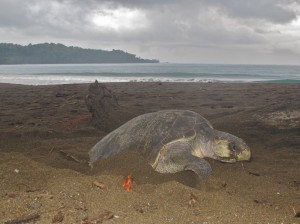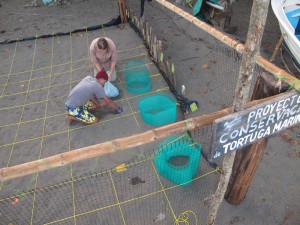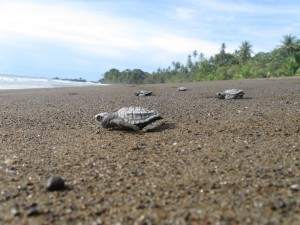 Costa Rica’s Pacific Coast is very important for the life cycle of a number of marine turtles. Most common found today are the “Lora” or Olive Ridley (Lepidochelys olivacea), in rapidly declining populations are the “Tortuga Negra” or Pacific Black or Green Sea Turtle (Chelonia mydas), the magnificent “Baula” or Leatherback (Dermochelys coriacea), and the “Carey” or Pacific Hawksbill Sea Turtle (Eretmochelys inbricata). Sadly due to the many odds against these most noble beings, all caused by human impacts, these four species are today critically endangered and on the verge of biological extinction. In 2010 only two Leatherbacks were registered in the southern part of the Osa Peninsula, and only 10 nests of the Pacific Hawksbill we located on two nesting beaches (representing 3 or 4 adult females) on our beach, Playa Rincón de San Josecito and playa Sombrero near Puerto Jimenez.
Costa Rica’s Pacific Coast is very important for the life cycle of a number of marine turtles. Most common found today are the “Lora” or Olive Ridley (Lepidochelys olivacea), in rapidly declining populations are the “Tortuga Negra” or Pacific Black or Green Sea Turtle (Chelonia mydas), the magnificent “Baula” or Leatherback (Dermochelys coriacea), and the “Carey” or Pacific Hawksbill Sea Turtle (Eretmochelys inbricata). Sadly due to the many odds against these most noble beings, all caused by human impacts, these four species are today critically endangered and on the verge of biological extinction. In 2010 only two Leatherbacks were registered in the southern part of the Osa Peninsula, and only 10 nests of the Pacific Hawksbill we located on two nesting beaches (representing 3 or 4 adult females) on our beach, Playa Rincón de San Josecito and playa Sombrero near Puerto Jimenez.
To protect the plummeting resident turtle population on the Osa Peninsula, specifically on the beach where we live we initiated this project, now going into it’s 9th year. Based on an invitation from Gabriel Palacios, a local community leader and park ranger, and the evident need to assist these species during the vulnerable moment of nesting we initiated our Marine Turtle Conservation efforts. Some of the hazards they face on shore are both human and animal poachers as well as from the changes of beach habitat that have caused the majority of the sand banks to be removed by the oceans waves, making it that the nests are often washed away by the high tide. With these considerations, for the first time in over 100 million years of their existence on earth, they need our help to survive as a species.
 The principal objectives of this project are to relocate the nests into a protected hatchery where they hatch with higher success rates. Still there are great odds again them in the ocean and it is believed that one in a thousand baby turtles will reach adulthood. To increase their chances of survival, they are released at night in small groups of approx 30 turtles, this in order to avoid predation from fish awaiting off shore, increasing their chances to make it to the deep sea ocean currents where they float among the debris and seaweeds.
The principal objectives of this project are to relocate the nests into a protected hatchery where they hatch with higher success rates. Still there are great odds again them in the ocean and it is believed that one in a thousand baby turtles will reach adulthood. To increase their chances of survival, they are released at night in small groups of approx 30 turtles, this in order to avoid predation from fish awaiting off shore, increasing their chances to make it to the deep sea ocean currents where they float among the debris and seaweeds.
The project also involves environmental education and awareness among local villagers and at three local schools, where our resident biologist share with the school kids the projects updates and aspects of marine ecology. Since the onset of the project we have received more and more support from local villagers and many of the youth are joining as volunteers in the night patrols. This small project allows us to make a significant difference towards the conservation of critically endangered Marine Turtles as well as advance in the important effort of promoting environmental awareness among the local peoples.
The way an egg-bearing female finds her way to her nesting beach, after traveling in open sea for thousands of miles, is still a mystery! Some scientists believe that marine turtles are sensitive to Earth’s magnetic field and use it for navigation. They are often found coming to the same sandy beach and even to the very same stretch of beach they used in previous years. For this reason, is of the highest importance, to secure our location as a turtle nesting sanctuary for future generations of marine turtles.
mystery! Some scientists believe that marine turtles are sensitive to Earth’s magnetic field and use it for navigation. They are often found coming to the same sandy beach and even to the very same stretch of beach they used in previous years. For this reason, is of the highest importance, to secure our location as a turtle nesting sanctuary for future generations of marine turtles.
Due to the alarming decrease of sea turtles worldwide, specifically in Costa Rica, the Community of Rincón de San Josecito Beach on Costa Rica’s Osa Peninsula has seen the urgent need to protect the turtles that travel our waters, arriving annually to nest on our beach. We have the opportunity to help preserve these distinguished sentient beings that nest on our beach.
As residents on playa San Josecito, we have taken it on as an act of personal, social and ecological responsibility to carry out this program that has been financially supported by both private benefactors, friends and from percentage of guests tuition at Guaria de Osa Ecolodge. To complete this year, 2013 project, conservation funds are still necessary. We need help from donors and volunteers. Find out how to get involved “Here”
For photos please look see our Gallery or “Like” our Fundación Osa facebook page.

